#ferdinand ii of aragon
Text
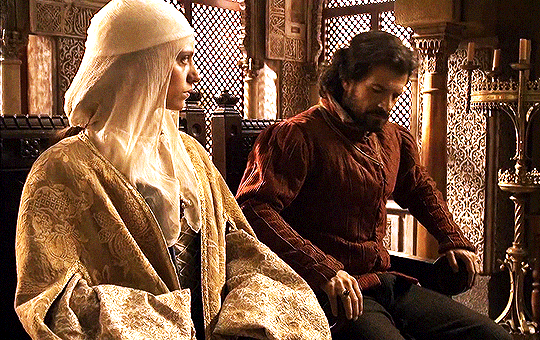




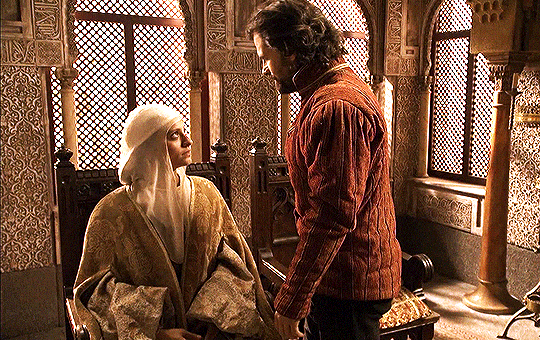
ISABEL TVE 2x06
#perioddramaedit#perioddramasource#weloveperioddrama#isabel tve#2x06#isabella i of castile#ferdinand ii of aragon#michelle jenner#rodolfo sancho
84 notes
·
View notes
Text
Random saints by Sittow or Catherine of Aragon's parents?

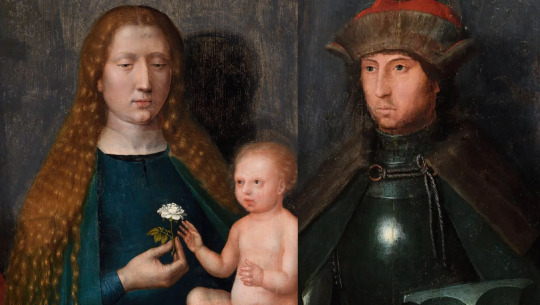
Read further if you wish to know what my theory is.
I first found this photo with mention it is by Sittow and at first I thought it is another portrait of Catherine. But quickly I realised this woman looks older and the features are not exactly the same.
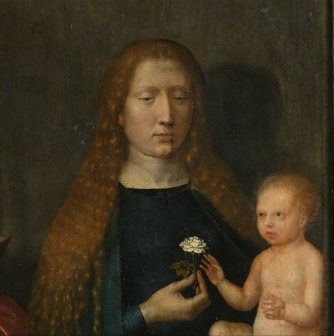
The nose is much narrower. And I started to wonder...we know that Sittow painted at least one portrait of Queen Isabella I of Castile.
And she had such nose. I could exclude possibility some of Catherine's sisters looked like this too, but women in that family tended to be very young-looking for really long.
So the age of sitter already is suggesting that it could be based upon Isabella towards end of her life. And it is also odd for depiction of Virgin Mary to depict woman who is not young...it is point in Isabella's favour.
While many claim Sittow painted Isabella in 1485, he was only born in 1468/1469 and didn't even become indipended master until at least 1488. He is first recorded working in Toledo in 1492. So he'd always be only able to depict Isabella over age of 40. And tbh, if this is her..then she looks great for somebody over 40!
But where is this image? It took me while to track down.
It's detail from wings of theThe Passion Altarpiece (Tallinn), its middle part is from c.1515-1520(with some 17th century additions) by different artist.

But I am not so sure how accurate is the dating of the outer wings by Sittow(1518-1525) which are in very different style, and might have originally belong to different altar middle.

If it is indeed 1518-1525 dating, then imo they are posthumous depictions based upon earlier sketches done from life. Sittow reusing those old sketches, using them as inspiration for his later work.
Link to photos only. Left pannel: https://artsandculture.google.com/asset/the-passion-altarpiece-outer-wing-with-the-virgin-mary-and-apostle-james-the-greater-paintings-of-the-outer-side-of-the-wings-by-michel-sittow-and-his-workshop/BwFnRG1v6gRqmQ
Right pannel: https://arthive.com/artists/75951~Michel_Sittow/works/526786~Saint_Adrian_and_Saint_Anthony
As to where they are located?
-Niguliste Museum(housed in former St. Nicholas' Church), which is part of Art Museum of Estonia(which combines collections from 3 other buildings+ this church). Hence in Tallin, Estonia but be aware there is over 3 km distance in between the church and other buildings.
But if anybody could go there and get us some pictures it'd be great (if it is allowed). Currently Niguliste Museum has exhibition about Sittow:

But back to the pannels. The left one depicts Madonna(Virgin Mary holding baby Jesus) and St. James the Great(apostle and patron saint of Spain:
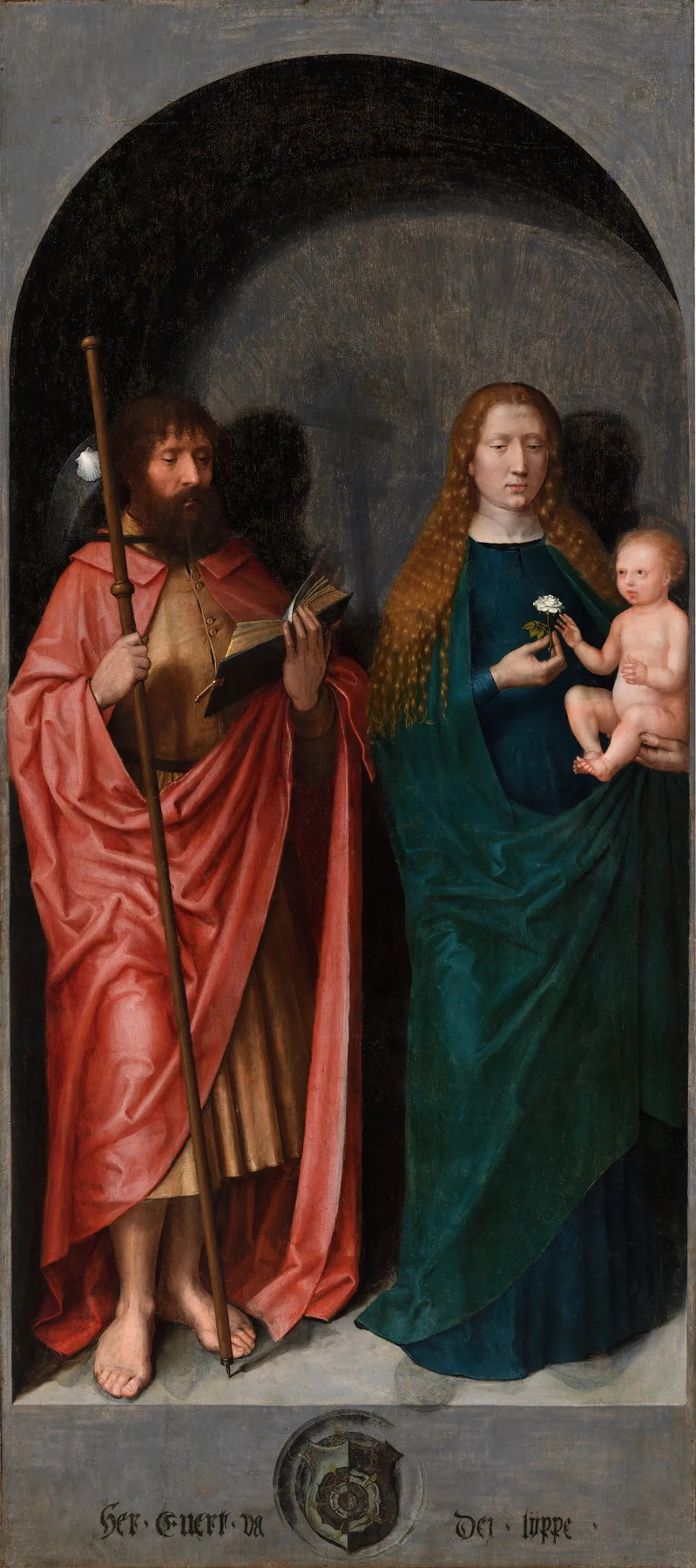
And please note that Tudor rose is combination of red and white rose and not always it was depicted as inner rose white, outer red. Sometimes they were halfed, with inner rose sometiems also switched.

Of course it could be some foreign coat of arms or later alteration.
Right pannel:

Here the coat of arms looks much newer and is probably altered(and if pomegranate turned out to be beneath it, I'd just die...)
The right pannel is depicting two male saints. On right is St Anthony the Great...was father of monasticism(of monastic life)...thus very important saint in christianity...
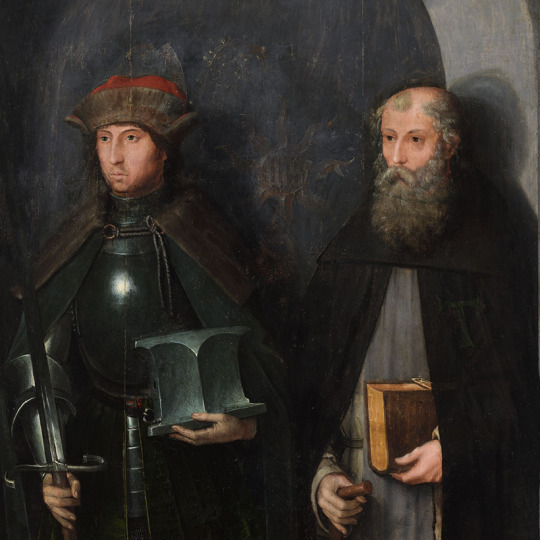
and on left St. Adrian of Nicomedia(2nd most popular military saint after St. George), and imo that's probably King Ferdinand II of Aragon:

It's not great likeness(brows not arched enough, looks bit slimmer, alla of nose not as defined), but overall it's enough of resemblence to not be able to exclude the possibility.
But if this is indeed done years after Sittow was in Spain...and he is reusing his old sketches of catholic monarchs to create this new religious scene(perhaps initially intended for them too, but never made into finished work before), then it is also possible that sketch done in pencil has partially rubbed off...and thus the differences in face of this male.
I think that if this was done while in Spain, such big differences are not very likely to occur. Not that pencil could not rub off, but I think Sittow would have noticed and cared about getting absolutely righ(to please his patrons) and thus would have corrected it.
Ehm, this kitty is supposed to be a lion:
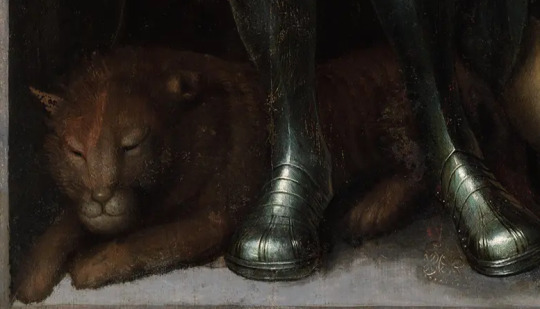
But you must be wondering, if Isabella indeed had this most vivid golden hair colour I always go on and on about, why does she have red hair here?
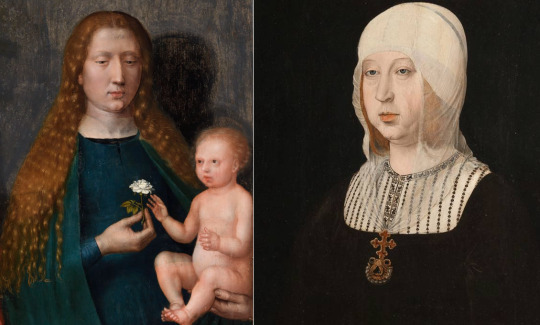
Several options to pick from: Pigments going wrong, Isabella's hair possibly turning to more reddish hues towards end of her life, or simply discoloured pinkish varnish which was very oddly applied...and on baby's skin you can see where somebody applied only one layer and where they went with brush for 2nd time.
If entire pannel has this varnish on, then it'd affect the hair, turning it more red. Why would such varnish not be removed? Sometimes money is tight and museums have multiple paintings to care for and those paintings in fairly good condition have to wait longer.
And sometimes it is not possible to remove discoloured varnish without harming the painting beneath.
Also worth of nothing is that Virgin Mary's dress is typically not teal, but vividly blue, the very best most expensive most vivid blue pigments were very often reserved for depicting the Virgin Mary:

Sometimes due to budget cost cheaper substitues were used, and those tend to fade.
Hence imo the colours originally might have been intended to be more like this(yes, I photoshopped it):

(I didn't change damn thing about male figure, just brightened it. But tbh I played with the woman's dress, skin and hair for while.)
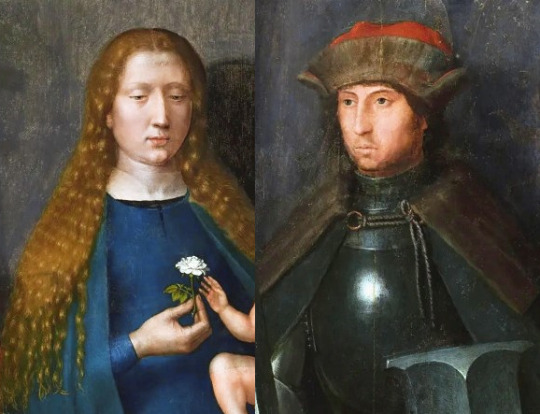
I mean if it looked like this now, fans of catholic monarchs would probably be all over it already.
But people overlook these dark slightly pinkish images located all the way in Estonia, even though it is atributed to Sittow himself!
(I don't mean people in Estonia, I mean people who search for Isabella's lost portrait by Sittow and stubbornly stuck to their favourite which is not even by Sittow!)

I honestly thought that people searching for lost portrait of Isabella by Sittow would have by now checked all his work, to see if perhaps she is there somewhere! Just doesn't look teen or young adult.
So I want you to be aware, if you're on quest of finding Isabella by Sittow's in that portrait with emerald necklace that this is imo the face you're looking for :

Possibly with hair bit more golden and skin more fair:
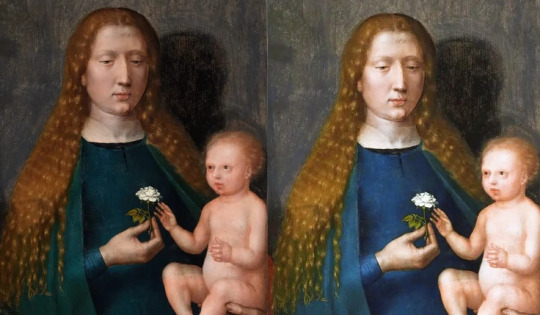
And it doesn't matter she doesn't look 20! She is still very beautiful.
Hence imo, these are Catherine of Aragon's parents, depicted in disguise of saints:

But I think they were likely painted years after Sittow left Spain, and his old sketches of them have been reused to create these pannels. I hope the experts will one day look more into this possibility.
I hope you've enjoyed this, and tell me what you think. Am I onto something or am I chasing shadows?


#historical portraits#isabella of castile#ferdinand of aragon#Isabella I of Castile#Ferdinand II of Aragon#sittow
69 notes
·
View notes
Text
Trastamara girls born after 1485 can’t cook. All they know is charge they phone, get abandoned by they father, eat hot chip, have complicated pseudo sexual relationship with male authority figure, twerk, and lie. (About their virginity.)
#the complicated relationship comment is about Mary & Chapuys/Catherine & Diego Fernandez#but if you’re one of those Phillipa Gregory girls it could always be about her and Henry VII :3#oh and you know who else? Mary and Cromwell#gotta throw Hilary Mantel a bone#thomas cromwell#mary i of england#katherine of aragon#eustace chapuys#diego fernandez#ferdinand ii of aragon#king henry viii
12 notes
·
View notes
Text
Some Spanish authors, however, did credit Mary herself or the couple working together for the restoration of Catholicism. Francisco Garrido de Villena, a caballero of Valencia, wrote that Mary, the “sovereign queen” who was “more than human,” worked “a miracle” in England by restoring the religion that had been “lost to a cursed Lutheran sect.” Bartolomé Carranza, the queen’s confessor, referred to Mary and Philip as the “Catholic Kings who restored the ancient and true religion.” Previously, the title “Catholic Kings” was associated with Isabel of Castile and Ferdinand of Aragon, Mary’s grandparents and Philip’s great-grandparents, who had united the two major kingdoms of Spain through their marriage in 1474 and conquered the Muslim Kingdom of Granada in 1492, thereby concluding the centuries-long Reconquista. Carranza made the connection between Isabel-Ferdinand and Mary-Philip explicit in his preface “to the pious reader” by referring to “the Catholic Kings,” meaning Isabel and Ferdinand, on the first page, then referring to “the Catholic Kings,” meaning Mary and Philip, on the next page, but whereas Isabel and Ferdinand had lived before Martin Luther and thus commanded the Bible to be translated into the vernacular, Mary and Philip removed vernacular Bibles in order to restore Catholicism to England, according to Carranza. For Spaniards, the implication of Carranza’s use of the title was that Mary and Philip were supervising a new reconquest, one that was less militarized if no less religiously contentious than the first. Further, his use of the masculine “kings” to refer to both Mary and Philip suggested an equality between them, just as Isabel and Ferdinand had maintained an equilibrium throughout their marriage.
— A Narrative That Was Not Her Own: Mary I as Mediterranean Queen by Darcy Kern, 2022. In Writing Mary I: History, Historiography, and Fiction, edited by Valerie Schutte and Jessica S. Hower
#historicalquotes#history#tudorerasource#Kern tag#dailytudors#mary i of england#philip ii of spain#marriage#parallels#religion#isabella i of castile#Bartolomé Carranza#ferdinand ii of aragon#*mine#*quotes
48 notes
·
View notes
Text

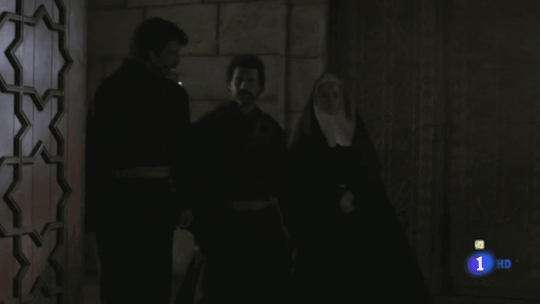


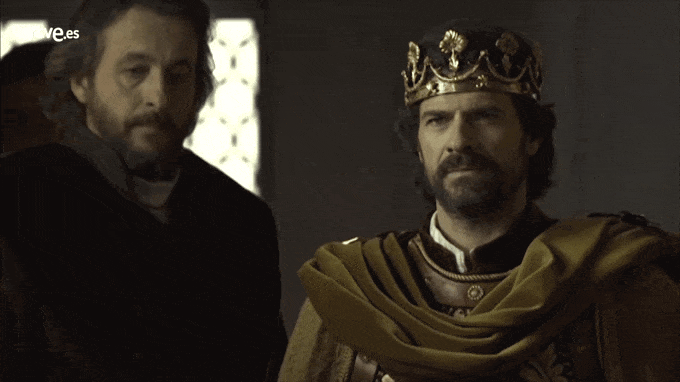
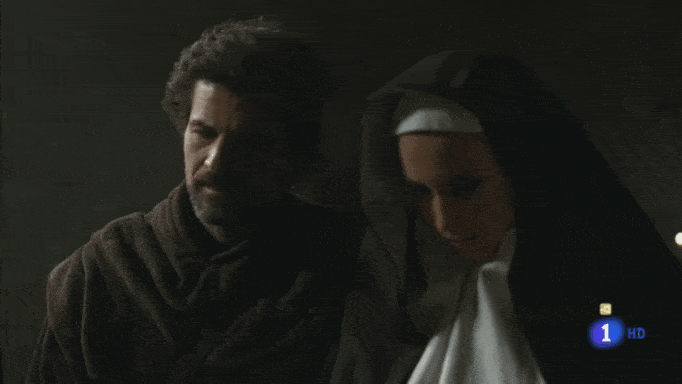

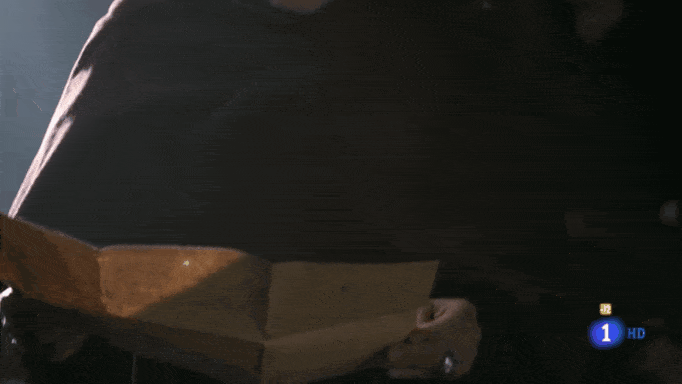


Juraría que la conozco de algo...
Isabel (2012-2014), 2×01 Desencuentros II El Ministerio del tiempo (2015-), 1×04 Una negociación a tiempo
#el ministerio del tiempo#isabel tve#1×04#una negociación a tiempo#2×01#desencuentros#nacho fresneda#aura garrido#rodolfo sancho#michelle jenner#eusebio poncela#ramón madaula#alonso de entrerríos#amelia folch#julián martínez#fernando ii de aragón#ferdinand ii of aragon#isabella i of castile#isabel i de castilla#cardenal cisneros#gonzalo chacón#francisco jiménez de cisneros#emdt#mdt
59 notes
·
View notes
Text

Columbus Before the Queen by Emanuel Leutze, 1843.
#classic art#painting#emanuel leutze#american artist#19th century#romanticism#history#early modern period#christopher columbus#isabella i of castile#ferdinand ii of aragon#royal court#people#inside#palatial interior
19 notes
·
View notes
Text
I just remembered that there is a comic where Robin ( Dick Grayson) and Wonder Woman travel in time to go to Isabella I of Castille's era:
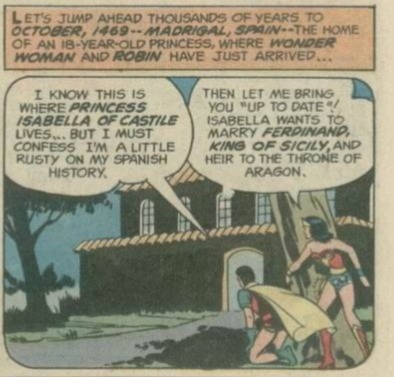

After completing their mission, preventing the time trapper to interfere, Isabella is free to marry Ferdinand:
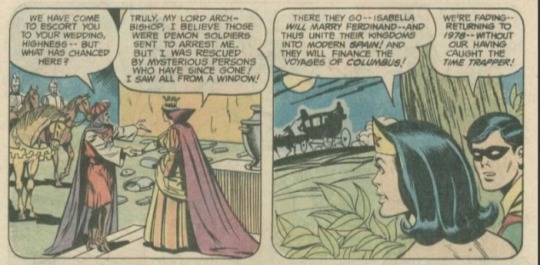
(The Super Friends issue #18)
16 notes
·
View notes
Text

The Queen is Mad is a musical psychodrama inspired by the true story of Joanna of Castile.
Cast
Natasha Hoeberigs (Joanna)

Alan Vicary (Ferdinand)

Brian Raftery (Philip).

3 notes
·
View notes
Text
TOMAS DE TORQUEMADA
1420-1498
Spanish friar, mass murderer, who had heretics tortured and burned alive
Tomás de Torquemada was a Spanish inquisitor and a Dominican friar; he became Spain’s first Inquisitor general in 1483. He met the young Princess Isabella I; they both had a strong religious rapport. He served as her regular confessor and advisor and was at her coronation in 1474, and advised her to marry King Ferdinand of Aragon in 1469. The Spanish Inquisition was a group that was created in 1478, to ‘uphold Catholic religious orthodoxy’ with the lands of Castile and Aragon (Kingdom of Spain).
Torquemada was a ruthless madman who persecuted heretics and became known for his use of torture and severe punishments. It is said that he had around 2,000 people killed by burning at the stake.
Muslims and Jews in Castile and Aragon had to convert to Catholicism for survival. Torquemada was one of the chief supporters of the Alhambra Decree that expelled the Jews from Castile and Aragon in 1492. Around 40,000 Jews were expelled from Spain and the rest converted to Catholicism so they could remain in Spain, who secretly remained Jewish.
Queen Isabella’s secretary wrote that 2,000 executions took place throughout her reign, which continued after Torquemada died. His health was failing in his final years and Pope Alexander VI appointed four assistants to assist him in the Inquisition. Torquemada retired to the monastery of St. Thomas Aquinas, Avila in 1494 and lived the life of a friar. He died at the monastery in 1498, aged 77, and was interred there. His tomb was ransacked in 1832, his bones were apparently stolen.
#tomasdetorquemada #ferdinandIIofaragon #isabellaIofcastile #atheism #history #truecrime

#tomas de torquemada#tomasdetorquemada#ferdinand ii of aragon#isabella i of castile#atheism#history#true crime
4 notes
·
View notes
Text




Rodolfo Sancho and Michelle Jenner as Fernando II of Aragon and Isabel of Castile in Isabel
#isabel tve#michelle jenner#rodolfo sancho#Isabel de Castilla#Fernando de Aragon#isabella of castile#ferdinand ii of aragon
33 notes
·
View notes
Text

15 notes
·
View notes
Note
Who is more powerful Isabella of Castile or Ferdinand of Aragon ? Or they have same power ? Are they only joint monarchs of Spain ?
I think it depends on how you look at it… Isabella was the sole owner of the Crown of Castile, which was bigger and richer than the Crown of Aragon, but Ferdinand became its co-ruler on the account of his marriage to her. (It’s worth mentioning he had his own claim, but Isabella’s was stronger.) He was the sole owner and ruler of the Crown of Aragon, Isabella was just his consort, making him the embodiment of the union between the two kingdoms. His interests in Italy made him a rival to be reckoned with, and his influence in Castile certainly enhanced his chances to win.
Isabella enhanced his power, and he helped her to get the throne and establish herself as queen since she wasn’t the obvious heir by any means. I think they were very powerful together and no one of them could be as powerful on their own.
There was another couple, Urraca I of Leon and Alfonso I of Aragon, she was the queen of Leon and Castile and he was the king of Aragon, but they didn’t get along and didn’t build anything together, so I will say Isabella and Ferdinand were the only joint rulers of the lands that formed Spain.
34 notes
·
View notes
Text
youtube
𝘐𝘴𝘢𝘣𝘦𝘭𝘭𝘢 𝘰𝘧 𝘊𝘢𝘴𝘵𝘪𝘭𝘦, 𝘍𝘦𝘳𝘥𝘪𝘯𝘢𝘯𝘥 𝘰𝘧 𝘈𝘳𝘢𝘨𝘰𝘯, 𝘵𝘩𝘦𝘪𝘳 𝘤𝘩𝘪𝘭𝘥𝘳𝘦𝘯 + 𝘵𝘩𝘦𝘪𝘳 𝘭𝘰𝘷𝘦𝘴
#isabella of castile#ferdinand ii of aragon#Isabel#Isabella of aragon#joanna the mad#joanna of castile#philip the handsome#catherine of aragon#henry viii#John of aragon#Maria of aragon#Manuel i of portugal#Michelle Jenner#Catalina de Aragon#Youtube
1 note
·
View note
Text
Aragon (ANT) Coin Yorum, Fiyat Tahmini 2022, 2023, 2024
#kripto #yorum #dolar #haber #aragon
#ant#aragon#bitcoin#btc#kriptohaber#binance#nft#kripto haber#finance#crypto#catalina de aragon#isabella of aragon#altın#ferdinand ii of aragon
0 notes
Text
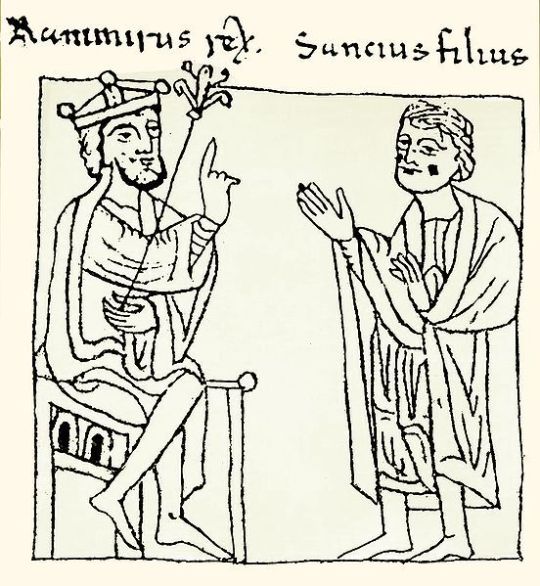



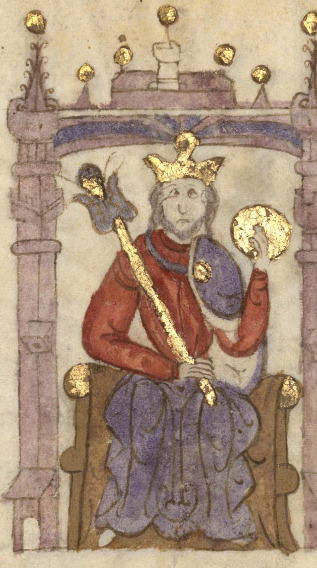

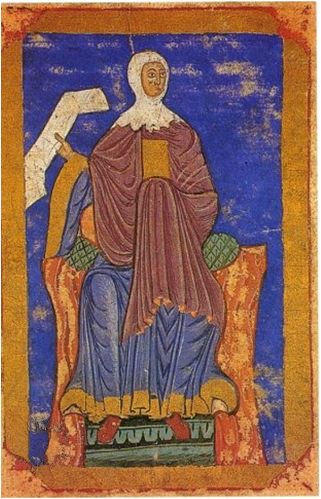

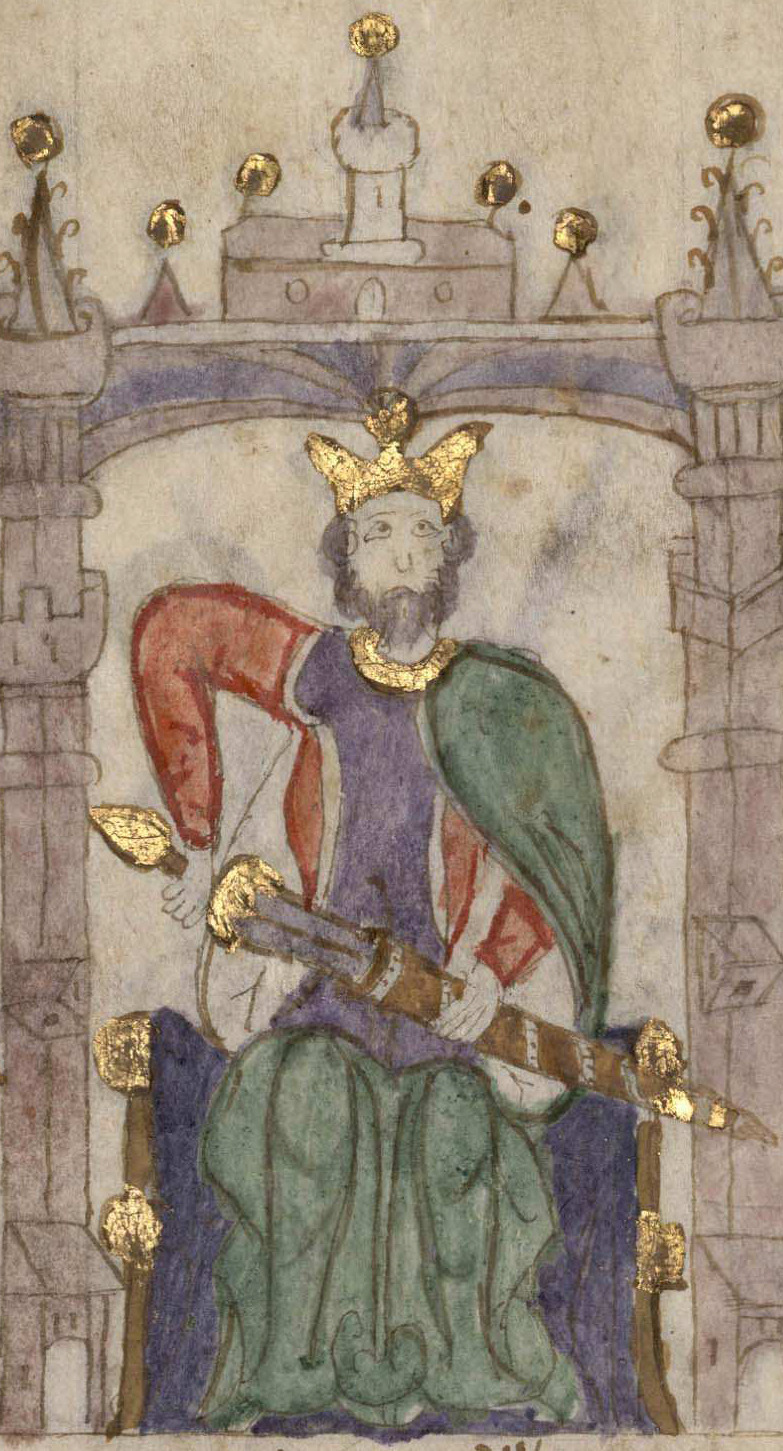

The Bastard Kings and their families
This is series of posts are complementary to this historical parallels post from the JON SNOW FORTNIGHT EVENT, and it's purpouse to discover the lives of medieval bastard kings, and the following posts are meant to collect portraits of those kings and their close relatives.
In many cases it's difficult to find contemporary art of their period, so some of the portrayals are subsequent.
1) Ramiro I of Aragon (1006/7- 1063), son of Sancho III of Pamplona and Sancha de Aybar; with his son Sancho I of Aragon & V of Pamplona (1043-1094)
2) His wife, Ermesinda of Foix (1015 - 1049), mother of Sancho I of Aragon. Daughter of Bernard Roger de Foix and his wife Garsenda de Bigorra; and Sancha of Aragon (1045-1097), daughter of Ramiro I and Ermesinda
3) His father, Sancho III of Pamplona (992/96-1035), son of García II of Pamplona and Jimena Fernández
4) His brother, García III of Pamplona (1012-1054), son of Sancho III of Pamplona and his wife Muniadona of Castile
5) His nephew, Sancho IV of Pamplona (1039- 1076), son of García III of Pamplona and his wife Placencia of Normandy
6) His brother, Ferdinand I of Leon (1016- 1065), son of Sancho III of Pamplona and his wife Muniadona of Castile
7) His niece, Urraca of Zamora (1033-1101), daughter of Ferdinand I of Leon and Sancha of Leon
8) His niece, Elvira of Toro (1038-1099), daughter of Ferdinand I of Leon and Sancha of Leon
9) Sancho II of Castile (1038/1039-1072), son of Ferdinand I of Leon and Sancha of Leon
10) Alfonso VI of Leon (1040/1041-1109), son of Ferdinand I of Leon and Sancha of Leon
#jonsnowfortnightevent#jonsnowfortnightevent2023#asoiaf#a song of ice and fire#day 10#echoes of the past#historical parallels#medieval bastard kings#ramiro i of aragon#sancho i of aragon#sancha of aragon#ermesinda of foix#sancho iii of pamplona#garcía iii of pamplona#sancho iv of pamplona#ferdinand i of leon#urraca of zamora#elvira of toro#sancho ii of castile#alfonso vi of leon#bastard kings and their families#canonjonsnow
26 notes
·
View notes
Text
In order to prevent Blanca (II of Navarre) from opposing the terms of the treaty and her disinheritance, it was decided to send her north on the pretext of marrying Charles, Duke of Berri and brother of Magdalena and Louis XI. When Blanca rejected the idea of the match and refused to leave Navarre, she was taken by force. By April 23, she had reached the monastery of Roncesvalles, where she wrote a lengthy missive, protesting about her abduction, claiming “my father took me by force and contrary to my will.” In this document, Blanca repeatedly refers to herself as “the firstborn [eldest] and queen regnant and Lady and heiress of the said kingdom,” which she noted came to her through “the maternal line.” The princess castigated her father for his treatment of the Principe de Viana, claiming Juan had “forgotten the love and paternal duty” that he owed his eldest son. Blanca also blamed her sister and brother-in-law’s ambition to rule Navarre for her plight; “The said Count of Foix and his wife, my sister, are taking me to exile me and to disinherit me of my kingdom of Navarre.”
Blanca became increasingly desperate as she was taken further north, drafting appeals for help to her former husband, the King of Castile, her cousin the Count of Armagnac and the head of her Beaumont supporters. By April 30, she gave up her brave defense of her position as the rightful queen and attempted to donate her right to the crown to her ex-husband, Enrique of Castile, rather than see the kingdom go to her younger sister. Once Blanca reached the northern frontier of Navarre, she was transferred to the custody of the Captal de Buch and imprisoned in the castle of Orthez, a stronghold that belonged to her brother-in-law, Gaston of Foix.
Blanca’s removal did not quiet her supporters or end the struggle over the succession of the realm. Civil war still raged between the Beaumonts, who championed Blanca, and their rivals, the Agramonts, and matters had been made worse by Enrique of Castile’s decision to invade Navarre to press the claim to the throne that his ex-wife had bestowed on him. The Bishop of Pamplona attempted to resolve the situation with the Accord of Tafalla in late November 1464, which called for Blanca’s return to Navarre in order to settle the matter of the succession. Unfortunately, Blanca was unable to respond to the summons as she died, rather suspiciously, shortly afterward on December 2, 1464. Her sister Leonor has been repeatedly accused by chroniclers, historians, novelists, and other writers of being involved in Blanca’s death, although there is little definitive evidence to support this allegation. There is no doubt that Leonor had a motive for her sister’s murder, but Courteault has argued that given that only ten days lapsed between the ratification of the agreement and the death of the princess, it is difficult to claim that Blanca was killed specifically in response to the drafting of the accord. The eighteenth-century historian Enrique Flórez accurately summed up Blanca’s difficult position: “because [she] did not have the strength to maintain the right to the crown, she lost not only the kingdom, but her freedom and her life.
-Elena Woodacre, "The Queens Regnant of Navarre: Succession, Politics and Partnership, 1274-1512"
#💔#Juan the Faithless is one of the worst historical fathers I have ever read about#he was beyond awful#he destroyed his son's life as well#Juana of Castile was his granddaughter and was treated just as badly by HER father (Juan the Faithless's son Ferdinand II of Aragon)#i guess this is where he learnt it from#historicwomendaily#blanca ii of navarre#blanche ii of navarre#15th century#my post
5 notes
·
View notes